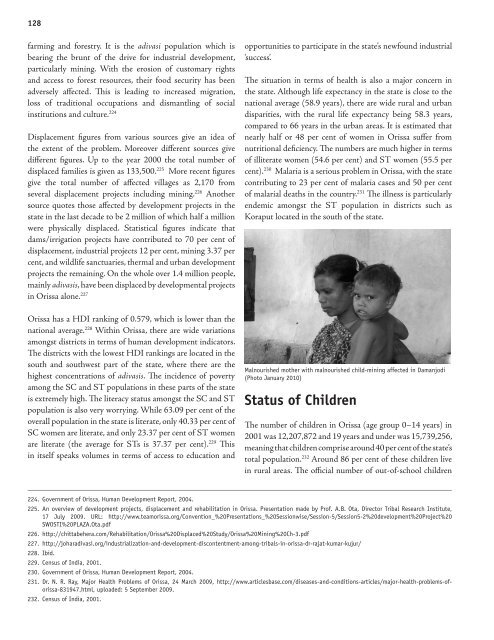Children - Terre des Hommes
Children - Terre des Hommes
Children - Terre des Hommes
Create successful ePaper yourself
Turn your PDF publications into a flip-book with our unique Google optimized e-Paper software.
128<br />
farming and forestry. It is the adivasi population which is<br />
bearing the brunt of the drive for industrial development,<br />
particularly mining. With the erosion of customary rights<br />
and access to forest resources, their food security has been<br />
adversely affected. This is leading to increased migration,<br />
loss of traditional occupations and dismantling of social<br />
institutions and culture. 224<br />
Displacement figures from various sources give an idea of<br />
the extent of the problem. Moreover different sources give<br />
different figures. Up to the year 2000 the total number of<br />
displaced families is given as 133,500. 225 More recent figures<br />
give the total number of affected villages as 2,170 from<br />
several displacement projects including mining. 226 Another<br />
source quotes those affected by development projects in the<br />
state in the last decade to be 2 million of which half a million<br />
were physically displaced. Statistical figures indicate that<br />
dams/irrigation projects have contributed to 70 per cent of<br />
displacement, industrial projects 12 per cent, mining 3.37 per<br />
cent, and wildlife sanctuaries, thermal and urban development<br />
projects the remaining. On the whole over 1.4 million people,<br />
mainly adivasis, have been displaced by developmental projects<br />
in Orissa alone. 227<br />
Orissa has a HDI ranking of 0.579, which is lower than the<br />
national average. 228 Within Orissa, there are wide variations<br />
amongst districts in terms of human development indicators.<br />
The districts with the lowest HDI rankings are located in the<br />
south and southwest part of the state, where there are the<br />
highest concentrations of adivasis. The incidence of poverty<br />
among the SC and ST populations in these parts of the state<br />
is extremely high. The literacy status amongst the SC and ST<br />
population is also very worrying. While 63.09 per cent of the<br />
overall population in the state is literate, only 40.33 per cent of<br />
SC women are literate, and only 23.37 per cent of ST women<br />
are literate (the average for STs is 37.37 per cent). 229 This<br />
in itself speaks volumes in terms of access to education and<br />
opportunities to participate in the state’s newfound industrial<br />
‘success’.<br />
The situation in terms of health is also a major concern in<br />
the state. Although life expectancy in the state is close to the<br />
national average (58.9 years), there are wide rural and urban<br />
disparities, with the rural life expectancy being 58.3 years,<br />
compared to 66 years in the urban areas. It is estimated that<br />
nearly half or 48 per cent of women in Orissa suffer from<br />
nutritional deficiency. The numbers are much higher in terms<br />
of illiterate women (54.6 per cent) and ST women (55.5 per<br />
cent). 230 Malaria is a serious problem in Orissa, with the state<br />
contributing to 23 per cent of malaria cases and 50 per cent<br />
of malarial deaths in the country. 231 The illness is particularly<br />
endemic amongst the ST population in districts such as<br />
Koraput located in the south of the state.<br />
Malnourished mother with malnourished child-mining affected in Damanjodi<br />
(Photo January 2010)<br />
Status of <strong>Children</strong><br />
The number of children in Orissa (age group 0–14 years) in<br />
2001 was 12,207,872 and 19 years and under was 15,739,256,<br />
meaning that children comprise around 40 per cent of the state’s<br />
total population. 232 Around 86 per cent of these children live<br />
in rural areas. The official number of out-of-school children<br />
224. Government of Orissa, Human Development Report, 2004.<br />
225. An overview of development projects, displacement and rehabilitation in Orissa. Presentation made by Prof. A.B. Ota, Director Tribal Research Institute,<br />
17 July 2009. URL: http://www.teamorissa.org/Convention_%20Presentations_%20Sessionwise/Session-5/Session5-2%20development%20Project%20<br />
SWOSTI%20PLAZA.Ota.pdf<br />
226. http://chittabehera.com/Rehabilitation/Orissa%20Displaced%20Study/Orissa%20Mining%20Ch-3.pdf<br />
227. http://joharadivasi.org/industrialization-and-development-discontentment-among-tribals-in-orissa-dr-rajat-kumar-kujur/<br />
228. Ibid.<br />
229. Census of India, 2001.<br />
230. Government of Orissa, Human Development Report, 2004.<br />
231. Dr. N. R. Ray, Major Health Problems of Orissa, 24 March 2009, http://www.articlesbase.com/diseases-and-conditions-articles/major-health-problems-oforissa-831947.html,<br />
uploaded: 5 September 2009.<br />
232. Census of India, 2001.






